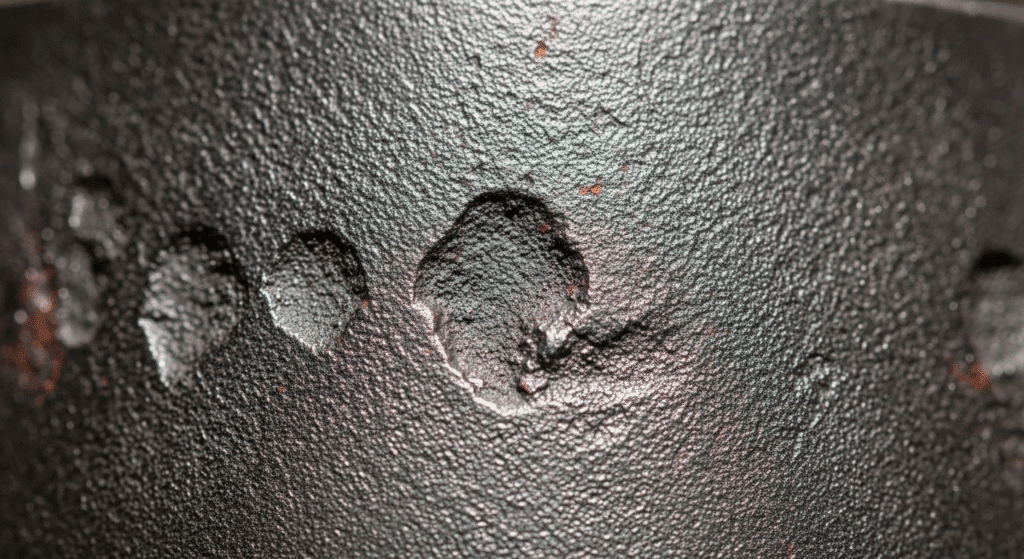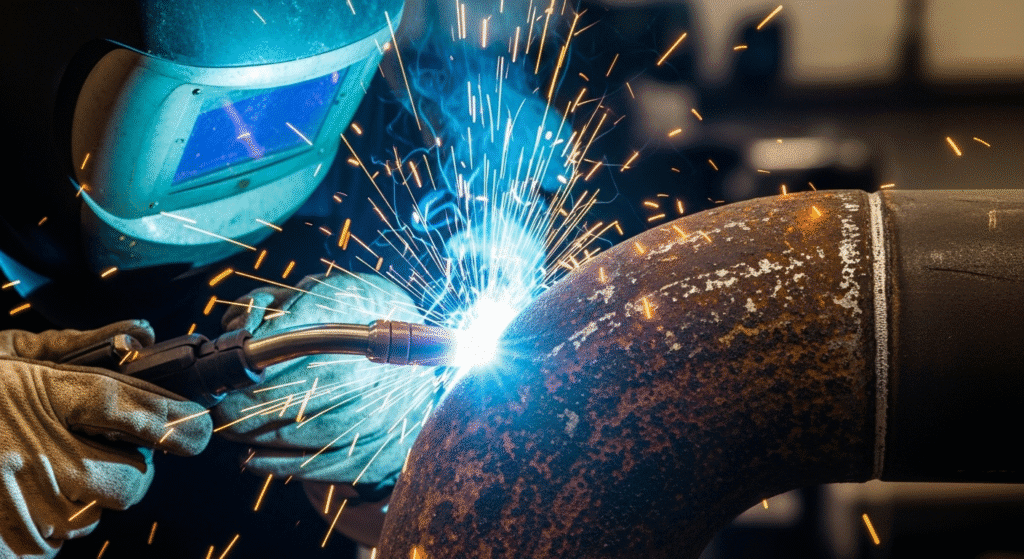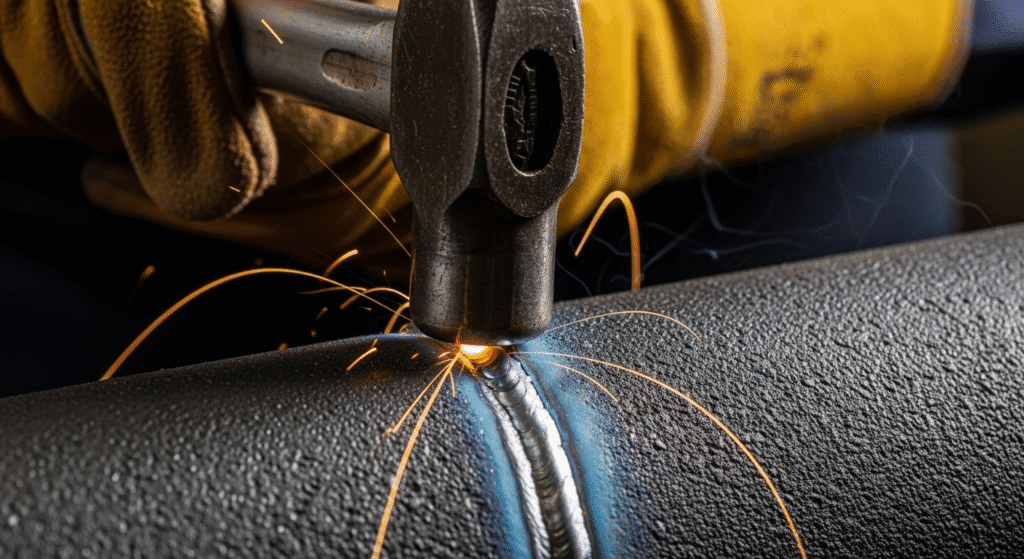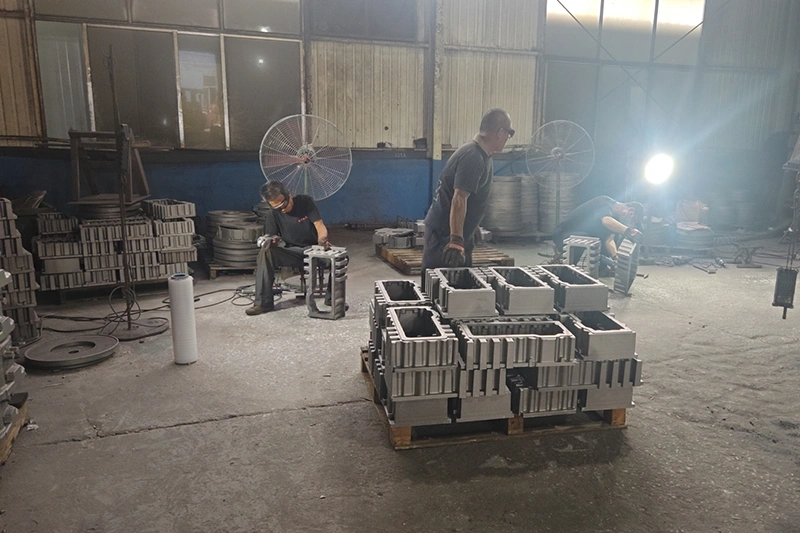Welding cast iron is challenging but completely doable when you follow the right steps. The key is understanding which type of cast iron you’re working with, properly preparing the metal, and controlling the heat throughout the entire process.
Most cast iron welding failures happen because welders treat it like steel. Cast iron contains much more carbon, making it brittle and prone to cracking when heated and cooled too quickly.

Not all cast iron welds the same way. Your success depends entirely on identifying which type you’re dealing with before you strike an arc.
Gray cast iron is the most common type you’ll encounter and the easiest to weld. It gets its name from the gray color you’ll see when you break it.
The carbon in gray cast iron exists as flakes of graphite. These flakes actually help absorb stress during welding, making it less likely to crack than other types.
You can successfully weld gray cast iron using stick welding with nickel rods or brazing. Just remember to preheat it to at least 500°F first.
Ductile cast iron is stronger and more flexible than gray cast iron, but it’s trickier to weld. The carbon forms tiny spheres instead of flakes, which changes how it responds to heat.
When you weld ductile iron, those carbon spheres can transform into brittle carbides if you’re not careful. This makes proper temperature control absolutely critical.
Stick to low-hydrogen electrodes and keep your heat input minimal. Preheating to 600-700°F helps prevent cracking.
White cast iron is nearly impossible to weld successfully. The carbon combines with iron to form extremely hard carbides throughout the entire structure.
These carbides make white cast iron so brittle that it’ll crack just from the stress of cooling. Most welders won’t even attempt it.
If you absolutely must repair white cast iron, brazing is your only real option. Even then, success isn’t guaranteed.
Malleable cast iron starts as white cast iron that’s been heat-treated to make it more workable. This process creates a material that’s tough but still weldable with the right approach.
The challenge is that welding heat can reverse the heat treatment. Your weld area becomes brittle white cast iron again.
Use the lowest heat input possible and consider brazing instead of welding. If you must weld, use nickel-based electrodes and extensive preheating.
Austenitic cast iron contains high levels of nickel, making it non-magnetic and highly resistant to heat and corrosion. It’s commonly used in exhaust manifolds and turbo housings.
This type welds better than most cast irons because it doesn’t form brittle phases as easily. The nickel content keeps it more stable during heating and cooling.
You can weld it with nickel or stainless steel electrodes. Preheating isn’t always necessary, but it still helps reduce stress.

Start by grinding away all rust, paint, oil, and grease from the weld area. Cast iron is porous and absorbs contaminants that will ruin your weld.
Use a grinder to create a V-groove along the crack or joint. Make the groove at least 1/8 inch deep to ensure good penetration.
Clean at least 1 inch on either side of the weld area. Any contamination near the weld will get pulled in by the heat.
Preheating is the most critical step in cast iron welding. It reduces the temperature difference between the weld area and the surrounding metal, preventing cracks from thermal stress.
Heat the entire part slowly and evenly to 500-1200°F, depending on the type and thickness. Use a propane torch, oven, or forge to bring the whole piece up to temperature.
Check the temperature with heat-indicating crayons or an infrared thermometer. Don’t guess – being off by even 100°F can cause failure.
Your choice of welding method and electrode makes or breaks the repair. Each method has specific advantages for different situations.
Stick welding with nickel electrodes is the most reliable method for cast iron repair. Nickel rods (ENi-CI or ENiFe-CI) stay soft and ductile as they cool, absorbing stress that would crack other welds.
Keep your arc as short as possible and use a low amperage setting. Weld in short 1-inch beads, then let the metal cool slightly before continuing.
Peening each bead while it’s still hot helps relieve stress. Just tap it lightly with a ball-peen hammer as it cools from red to black.
TIG welding gives you the best control over heat input, making it ideal for thin cast iron sections. You can precisely control the puddle and minimize the heat-affected zone.
Use silicon bronze or nickel filler rods with pure argon shielding gas. Keep your tungsten sharp and maintain a tight arc length.
The downside is that TIG requires more skill and takes longer than stick welding. It’s best for precision work rather than heavy repairs.
MIG welding cast iron is possible but not recommended for critical repairs. The high heat input and fast travel speed make crack prevention difficult.
If you must use MIG, choose a nickel-based wire and use the lowest voltage setting that still gives good fusion. Work in very short bursts to minimize heat buildup.
Flux-cored wires designed for cast iron work better than solid wires. They provide some slag protection and better arc characteristics.
Brazing is often the best choice for cast iron because it uses much lower temperatures than welding. The brass filler metal melts around 1600°F, well below cast iron’s melting point.
Clean and flux the joint thoroughly before brazing. Heat the base metal until the brass rod melts on contact, then flow it into the joint.
The brazed joint won’t be as strong as a weld, but it’s much less likely to crack. It’s perfect for non-structural repairs and thin sections.
Peening each weld bead while it’s cooling helps prevent cracks by relieving internal stress. Strike the weld with a ball-peen hammer while it’s cooling from red heat to black.
Don’t hit too hard – you’re stretching the metal slightly, not trying to flatten it. Light, rapid taps work better than heavy blows.
Continue peening intermittently as the metal cools. This keeps relieving stress as the metal contracts.

Cooling cast iron too quickly is the fastest way to create cracks. The entire part needs to cool slowly and evenly over several hours.
Bury the welded part in sand, lime, or vermiculite insulation immediately after welding. These materials slow the cooling rate dramatically.
For best results, let the part cool for at least 24 hours before handling it. The slower it cools, the less likely it is to crack.
Cooling the metal too quickly causes most cast iron welding failures. The rapid temperature change creates stress that cracks the brittle material. Always use preheating and slow cooling to prevent this.
You can sometimes skip preheating for very small repairs using nickel electrodes, but it’s risky. Preheating dramatically improves your success rate by reducing thermal stress and should be standard practice.
Break a small piece and look at the fracture surface. Gray cast iron looks gray and grainy, white cast iron appears white and crystalline, and ductile iron has a more metallic, steel-like appearance.
No, brazed joints are typically 50-75% as strong as welded joints. However, they’re much less likely to crack and work perfectly for many repairs, especially on thin sections or non-structural parts.

